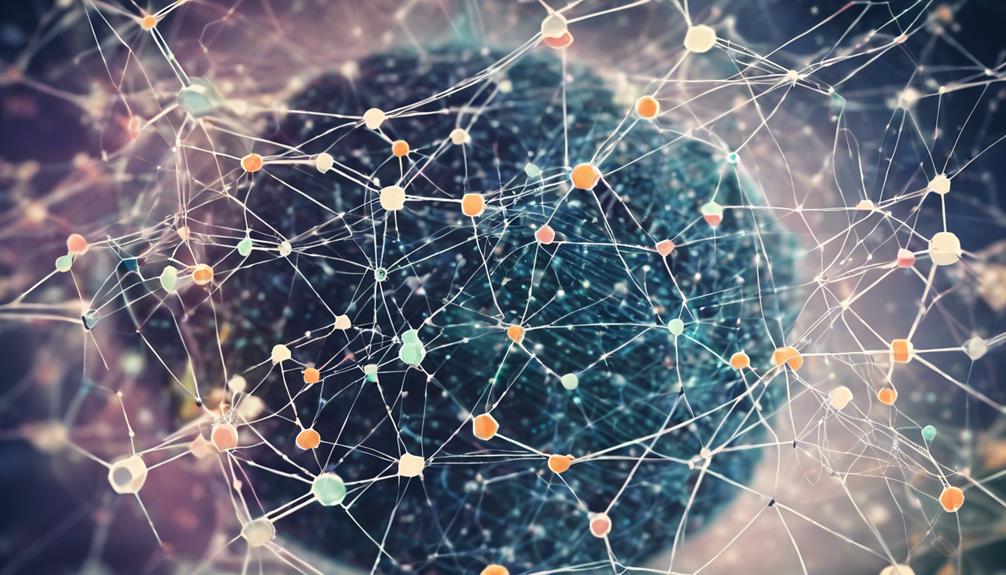In the dynamic domain of cybersecurity, Artificial Intelligence (AI) is revolutionizing digital defense by swiftly detecting threats and bolstering proactive security measures. AI algorithms analyze data in real-time, pinpoint anomalies, and enhance threat detection capabilities. They excel at predicting and mitigating advanced persistent threats. By using AI, businesses can proactively identify vulnerabilities, fortify defenses, and optimize security posture. Automated incident response systems reduce response time to cyber threats, staying ahead in the digital landscape. Embrace AI for its predictive capabilities, combatting threats effectively. Uncover how AI is transforming cybersecurity defenses with advanced technologies.
Key Takeaways
- AI enhances threat detection with real-time analysis.
- Proactive predictive analytics fortify cybersecurity defenses.
- AI combats advanced persistent threats effectively.
- Enhanced phishing detection through AI-driven mechanisms.
- Automated response systems rapidly mitigate cyber threats.
AI-Powered Threat Detection
AI-Powered Threat Detection plays a pivotal role in modern cybersecurity strategies by leveraging artificial intelligence algorithms to analyze data and identify potential cyber threats in real-time. These AI-driven systems are revolutionizing digital security by sifting through vast amounts of data to pinpoint anomalies and suspicious activities that traditional security measures might overlook.
By continuously learning from new data and patterns, machine learning algorithms enhance their threat detection capabilities, staying ahead of evolving cyber threats.
In the field of cybersecurity, AI is transforming how organizations defend against digital threats. Automated incident response, made possible by AI, greatly reduces the response time to cyber threats, bolstering overall security posture. Additionally, AI-driven systems excel at proactively identifying and mitigating advanced persistent threats (APTs), outpacing agile hackers.
Remarkably, AI enhances phishing detection by scrutinizing email content for malicious elements and adapting to block phishing attempts effectively based on user behavior patterns. The integration of AI in cybersecurity is a game-changer that fortifies defenses in the ever-evolving digital landscape.
Predictive Risk Assessment Capabilities

Harnessing predictive analytics, organizations can preemptively fortify their cybersecurity defenses against emerging threats. By utilizing predictive capabilities, businesses can proactively identify vulnerabilities and potential attack vectors, allowing them to take decisive action before cyber threats escalate. This shift from reactive to predictive analysis empowers organizations to stay ahead of evolving threats, greatly enhancing their threat response efficiency.
Predictive risk assessment enables companies to fortify their defenses based on data-driven insights, optimizing their security posture. By leveraging AI to predict cybersecurity risks before they materialize, organizations can streamline their security strategies, making them more resilient to advanced cyber threats.
Embracing predictive analysis not only bolsters defenses but also fosters a culture of proactive cybersecurity measures.
Combatting Advanced Persistent Threats

Advanced Persistent Threats (APTs) are formidable adversaries in the cybersecurity landscape, often evading traditional security measures.
AI-driven threat detection leverages vast data analysis to unearth hidden APT activities, bolstering proactive threat mitigation strategies.
Understanding adversaries' tactics is paramount in fortifying defenses, and AI's role is pivotal in this ongoing battle against sophisticated cyber threats.
Ai-Driven Threat Detection
Utilizing artificial intelligence for threat detection is instrumental in countering the complexities of Advanced Persistent Threats (APTs) in cybersecurity. AI-driven systems have the ability to analyze vast datasets, enabling the identification of subtle patterns indicative of potential threats posed by APTs. Unlike traditional security measures, AI can adapt and evolve to the changing landscape of cybersecurity solutions and evolving cyber threats, making it a powerful tool in threat detection.
| AI-Driven Threat Detection Benefits | |
|---|---|
| Enhances Detection Capabilities | By analyzing vast datasets, AI can uncover hidden APTs and dissect complex attack patterns. |
| Mitigates APTs Effectively | Understanding adversary tactics is key in combating APTs, and AI plays a crucial role in this aspect. |
| Proactive Threat Detection | AI continuously adapts to evolving threats, enabling proactive measures against APTs. |
In the domain of cybersecurity, AI-driven threat detection stands as a beacon of hope in the ongoing battle against advanced and persistent cyber threats.
Proactive Threat Mitigation
In the domain of cybersecurity defense, proactive threat mitigation strategies are essential for effectively combating the stealthy and sophisticated nature of Advanced Persistent Threats (APTs). When addressing APTs, AI-driven cybersecurity solutions play a pivotal role in uncovering hidden APTs and dissecting adversary tactics.
Here's how organizations can enhance their defenses against APTs:
- Utilize AI for Threat Analysis: AI enables the analysis of vast datasets to identify hidden APTs and understand evolving threat landscapes. By dissecting complex attack patterns, organizations can proactively mitigate threats.
- Learn Adversary Tactics: Understanding the tactics, techniques, and procedures (TTPs) of adversaries through AI empowers organizations to stay ahead in combatting APTs. By leveraging AI insights, organizations can enhance their defense mechanisms.
- Continuous Learning for Threat Prevention: AI-driven cybersecurity solutions excel at continuously learning from evolving threat landscapes. This adaptive approach ensures organizations can detect, respond to, and prevent advanced cyber threats effectively, staying one step ahead of malicious actors.
Enhancing Phishing Detection Mechanisms

AI cybersecurity systems have made significant strides in enhancing phishing detection mechanisms by leveraging machine learning algorithms to analyze email content and user behavior. This advancement in technology allows for a more proactive approach in identifying and mitigating potential threats posed by phishing attacks. The effectiveness of AI-driven tools for threat detection is evident in their ability to adapt to evolving threats, from traditional phishing to advanced and elusive tactics.
| AI's Impact on Phishing Detection | ||||
|---|---|---|---|---|
| Enhanced Email Filtering | User Behavior Analysis | Sophisticated Threat Detection | Prevention Measures | Adaptation to New Threats |
| Analyzes email content for malicious elements | Learns from user behavior for accurate detection | Identifies elusive phishing attempts | Effective in blocking phishing attacks | Adjusts to evolving threat landscapes |
Through AI technologies, cybersecurity professionals can better detect suspicious activities within email communications, ultimately strengthening the defense against phishing attempts. The incorporation of AI in cybersecurity strategies marks a significant advancement in safeguarding digital assets from malicious cyber threats.
Automated Response Systems

Automated response systems in cybersecurity leverage AI technology to swiftly detect and counteract potential threats. These systems play an essential role in enhancing digital defense by taking immediate action against cyber threats.
Here's why they are important:
- Real-time Analysis: Automated response systems continuously analyze vast amounts of data in real-time, allowing for the quick identification of anomalies and potential attacks.
- AI-driven Automation: By utilizing AI-driven automation, these systems can respond rapidly to threats, reducing response time and mitigating the impact of potential attacks.
- Proactive Measures: Shifting from reactive to proactive security measures, automated response systems implement proactive measures that outpace agile hackers, preventing breaches and strengthening overall cybersecurity defenses.
Incorporating automated response systems into cybersecurity strategies is essential in today's digital landscape to stay ahead of ever-evolving cyber threats.
Proactive Defense Strategies

Utilizing predictive analytics and preemptive measures, proactive defense strategies in cybersecurity aim to anticipate and thwart potential threats before they materialize. AI systems play a pivotal role in this shift by continuously analyzing vast amounts of data to predict threats and identify potential attack vectors. By moving from reactive to proactive defense strategies, organizations can fortify their security posture and stay ahead of cyber adversaries. This shift to predictive cybersecurity is facilitated by advanced algorithms that enable rapid threat response, outpacing the agility of hackers.
Implementing proactive defense measures empowers organizations to proactively prevent threats rather than merely reacting to incidents after they occur. By embracing this proactive approach, businesses can establish a robust security framework that anticipates and mitigates risks effectively. This change in cybersecurity strategy marks a significant advancement in defending against evolving cyber threats, emphasizing the importance of staying vigilant and leveraging technology to enhance overall defense mechanisms.
Frequently Asked Questions
How AI Can Be Used in Cyber Security Defences?
AI enhances cybersecurity defenses by analyzing data in real-time, detecting anomalies, and continuously evolving threat detection with machine learning algorithms. Its dynamic defense mechanism adapts and learns, revolutionizing incident response and enabling proactive threat prediction.
How Artificial Intelligence Is Revolutionizing Cybersecurity?
Artificial intelligence is revolutionizing cybersecurity by greatly enhancing threat detection capabilities through real-time analysis of data. Its adaptive learning enables refined algorithms, dynamic defense mechanisms, automated incident response, and efficient anomaly detection, all contributing to proactive and robust digital defense strategies.
Is AI Going to Replace Cyber Security?
AI is not replacing cybersecurity but enhancing it. By providing advanced threat detection and response capabilities, AI complements human expertise. Its integration allows for proactive measures to prevent attacks, enabling faster and more accurate threat detection and mitigation.
How Does Generative AI Affect Cybersecurity?
Generative AI has a profound impact on cybersecurity by enabling the creation of deceptive content, such as deepfakes and phishing attacks. Its ability to mimic human behavior challenges traditional defenses, necessitating advanced detection methods to mitigate evolving cyber threats.
Conclusion
To sum up, as the saying goes, 'prevention is better than cure.' AI cybersecurity is revolutionizing digital defense by enhancing threat detection, risk assessment capabilities, and combatting advanced persistent threats.
With automated response systems and proactive defense strategies, organizations can stay ahead of cyber threats and protect sensitive information. By leveraging AI technologies, businesses can strengthen their cybersecurity posture and mitigate potential risks effectively.
Remember, staying proactive is key in safeguarding against evolving cyber threats.









